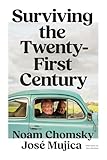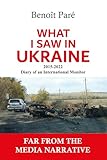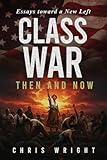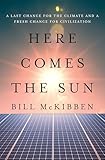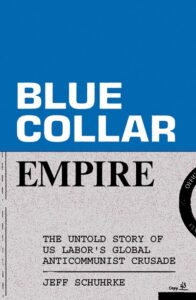 On December 2, 2024, MLToday posted Ruth Needleman’s review of Jeff Schuhrke’s outstanding book, Blue Collar Empire: The Untold Story of US Labor’s Global Anticommunist Crusade (London: Verso). Without taking anything away from either the reviewer or the author, I would like to make a few supplementary points.
On December 2, 2024, MLToday posted Ruth Needleman’s review of Jeff Schuhrke’s outstanding book, Blue Collar Empire: The Untold Story of US Labor’s Global Anticommunist Crusade (London: Verso). Without taking anything away from either the reviewer or the author, I would like to make a few supplementary points.
Needleman credits Schuhrke with providing “a clearly written, comprehensive and meticulously documented account of the AFL-CIO’s decades of subversive actions aimed at dividing, replacing or just destroying labor federations and movements throughout the world.” In the name of fighting communism, this campaign began before the Cold War, peaked during the Cold War and continues after the Cold War under the auspices of the AFL-CIO’s Solidarity Center. By undermining militant trade unionism and pro-labor political leaders in Europe and the Third World, the AFL-CIO not only palpably worsened the wages and conditions of workers abroad but also injured American workers by diverting resources that could have been used for domestic organizing to the pursuit of the government’s foreign policy objectives and by making these countries more attractive for American capital investment encouraged the deindustrialization that began in earnest in the 1980s.
All that Needleman says is true, but it leaves out part of the story, namely why did labor play this role?
One could come away from Needleman’s review as well as many other accounts by thinking that labor’s anti-communism just represented a kneejerk response to the Cold War or a kind of psychological disturbance, a form of paranoia. Of course, labor’s anticommunism did reflect the times and had an exaggerated and irrational aspect. Schuhrke, however, explains that labor’s anti-communism was rooted in the dominant ideology of the labor movement that emerged under AFL leader Samuel Gompers in the 1890s. This was the ideology of class collaboration. This ideology posited that labor would benefit by cooperating with employers to increase production, productivity and profits and by eschewing strikes and other conflicts and by avoiding political involvement with any radical movements or parties. This ideology reflected the interests of what Karl Marx called the “labor aristocracy,” the most well-placed members of the labor movement.
The ideology of class collaboration did not reign uncontested. Throughout the history of American labor, another ideology opposed it, namely the ideology of class struggle. His ideology reflected an analysis by Karl Marx and others that under capitalism the interests of workers and capitalists were inherently and inevitably in conflict. Demands for better wages, shorter hours, and safer conditions inevitably conflicted with the capitalists’ desire for greater profits. In this situation, workers could advance only by using strikes, slowdowns, and other means of force to wring concessions from the capitalists. Early in his career as leader of the Cigarmakers, Samuel Gompers read Marx and more or less agreed with his analysis and its implications for trade unions. At a time when the Knights of Labor, the largest labor organization of its time, welcomed workers and nonworkers and relied on education and cooperatives to improve the workers’ lot rather than strikes, Gompers argued that workers needed an organization exclusively of workers, and one that defended the workers’ right to strike. By the end of the 19th century, as President of the AFL, Gompers changed beliefs and came to embody the ideology of class collaboration, and while not opposing strikes in principle, opposed them in practice.
In opposition to Gompers, the ideology of class struggle gained adherents. Before World War I the ideology of class struggle was embraced by the William Haywood and the Western Federation of Miners, Elizabeth Gurley Flynn and the Industrial Workers of the World, the Syndicalist League of North America, and leftwing Socialists like Eugene V. Debs. In the 1920s and early 1930s, the class struggle ideology found expression in William Z. Foster and the Communist Party and the Communist-initiated Trade Union Education League, and later the Trade Union Unity League. From the mid-1930s to the end of the 1940s, militant class struggle ideas served as the ideology of the Communists and other militants who organized the industrial unions of the CIO. After the expulsion of the so-called Communist-led unions by the CIO in 1949, the ideology of class conflict was largely confined to those unions that had been expelled and to pockets of Communists and leftists in other unions. George Meany and the leaders of the AFL-CIO trumpeted the dominant ideology of class collaboration.
Leading capitalists and politicians, at least among those not openly hostile to unions, supported the ideology of class collaboration. Promoting this ideology was the raison d’etre of the National Civic Federation, an organization of capitalists and union leaders formed in 1900, whose first president was the capitalist Republican Mark Hanna and whose vice-president was Samuel Gompers, president of AFL. Thus, the ideology of class collaboration represented the ideology of the capitalists within the labor movement. This ideology did not result in any meaningful gains for workers or labor. From 1900 until 1935, most workers labored under subsistence wages, long hours, unhealthy conditions, and less than 10 percent of the workers (mainly skilled workers, and miners and garment workers) belonged to a union.
This situation did not change until the mid-1930s when Communists, Socialists and other militants with a class struggle orientation succeeded in organizing the workers in such mass production industries auto, rubber, steel and electrical, waged successful strikes, won union recognition and collective bargaining agreements, and became the leaders of these unions.
The scandalous foreign policy that mainstream labor pursued and that Schuhrke describes cannot be understood apart from the equally scandalous behavior that most labor leaders followed at home. Needleman does not fully appreciate this connection. This is reflected by her neglect of Schuhrke’s discussion of the World Federation of Trade Unions (WFTU).
At the end of World War II, unions in the Allied countries formed the WFTU. This move was spearheaded by the Soviet trade unions and the CIO. Following meetings of representatives of the Soviet trade unions and the CIO, the CIO issued a document calling for cooperation of all the trade unions in the allied countries and the promotion of peace, justice and prosperity for all workers. In a preface, Phil Murray, President of the CIO, wrote, “I consider this document of first-rate importance, not only for American labor but for all who are interested in knowing the truth about the Soviet trade union movement and promoting friendship and understanding between the peoples of our two countries.”1George Morris, The CIA and American Labor: The Subversion of the AFL-CIO’s Foreign Policy (New York: International Publishers, 1967), 53.
As constituted in October 1945 and headquartered in Paris, the WFTU represented unions in 56 countries, representing 67,000,000 workers. The largest organizations were those of the USSR, Great Britain, the USA (CIO), Italy, France, and Latin America. The preamble of its constitution stated that its purposes, among others, were to organize and unite trade unions in the whole world, to assist workers in less developed countries in forming unions, to fight against fascism, to combat war and the causes of war, to support the economic, social and democratic rights of workers, as well as the worker security and full employment, the progressive improvement of wages, hours and working conditions, and social security for workers and their families.2William Z. Foster, Outline History of the World Trade Union Movement (New York: International Publishers, 1956), 404-407. Underpinning the WFTU was a shared ideology of militant, class- struggle unionism.
Schuhrke points out that the WFTU and its affiliated unions became the major target of the AFL’s disruptive anticommunist campaign. In 1945, the AFL established a Free Trade Union Committee (FTUC) which would serve in Schuhrke’s words as “its primary weapon for waging the Cold War.” Initially, free trade unions referred to unions purportedly not dominated by a Communist state, but “by 1945 the term was being used by the AFL as a synonym for anticommunist unionism. In other words, even if a union were autonomous and democratic, the AFL would still consider it illegitimate and ‘unfree’ if it happened to be led or influenced by communists.” This included, for example, the French CGT (General Confederation of Labor), the largest labor federation in France, two thirds of whose affiliates were led by Communists. After 1949, when the CIO’s expelled its leftwing unions and acquiesced in the Taft-Hartley Act’s requirement that all union officers sign non-Communist affidavits, the CIO leaders adopted the AFL’s “free trade unionism” position and rejected the WFTU. This meant not only the rejection of unions in Communist countries and unions anywhere led by Communists but also a rejection of the kind of class struggle unionism that these unions represented, that is to say a unionism rooted in the Marxist idea that the essential interests of labor and capital were in conflict, and that furthering the interests of labor required international cooperation and economic and political struggle on behalf of their interests and against the employers.
Support for “free trade unionism” meant that American labor leaders would become adjuncts of American foreign policy. It also meant adherence to a class collaboration ideology at home. It meant that AFL leaders like George Meany and the UAW (United Automobile Workers) leader Walter Reuther (head of the CIO after 1952) opposed the kind of progressive, class struggle oriented unionism that the WFTU and the CIO had hitherto stood for and adopted a unionism that prioritized class collaboration, the idea that the interests of workers was best served by cooperating with the employer and the foreign policy operations of the government. After World War II, Walter Reuther, who continues to enjoy an undeserved reputation as a progressive labor leader, actually spearheaded the class collaboration ideology. Schuhrke said, “Instead of a constant struggle for control of the workplace through strikes, slowdowns, and similar militant tactics, Reuther held that unionized workers would gain far more by behaving themselves on the shop floor and boosting production in exchange for getting to partner with government and industry in economic planning.”
Did the class collaboration bring workers and unions the benefits Reuther promised? It opened a spigot of government money to fund labor’s overseas operations, and gained leaders like Reuther a measure of respectability, but in the main, it produced the exact opposite of what was promised. Labor organizing diminished. The CIO abandoned Operation Dixie, its stillborn campaign to organize the South, which remained ever since a bastion of the open shop and right-to-work laws. After expelling eleven leftwing unions like the United Electrical Workers (UE) and the Farm Equipment Workers (FE) in 1949, the CIO devoted resources to raiding the members of the expelled unions instead of organizing the unorganized. The Communist and other militant organizers of the CIO’s heyday were shunted aside. Reuther and his followers weakened the steward system, abandoned the right to strike between contracts, extended the length of collective bargaining agreements (often to five years), introduced the idea that wage increases should be linked to productivity gains, initiated labor-management administered benefit programs, and downplayed civil rights, and made labor a junior partner of the Democratic Party. Meanwhile, the percentage of organized workers peaked in the mid-1950s at about 33 percent and declined thereafter. Today less than 10 percent of workers belong to unions. Moreover, in Left Out: Reds and America’s Industrial Unions, Judith Stepan-Norris and Maurice Zeitlin show, unions led by non-Communists, acted less militantly, gained worse contracts, and behaved less democratically than unions led by or influenced by Communists.
Moreover, by undermining militant trade unions abroad and cooperating with rightwing dictators who suppressed unions, the AFL-CIO contributed to the low wage environment in Latin America and Asia that produced the offshoring and deindustrialization that has plagued the American working class since the late 1970s.
In the end, Schuhrke’s treatment of labor’s global anticommunist crusade provides a more trenchant and far-reaching critique of mainstream labor leadership than even such a discerning reviewer as Needleman recognizes.
Schuhrke’s book provokes a question that goes beyond his focus on labor’s foreign policy. After the expulsion of the leftwing CIO unions in 1949, what happened to the militant, class struggle ideology? The radical tradition remained alive in what remained of the left-wing CIO as UE, FE and the Westcoast Longshoremen. Schuhrke shows that an echo of this ideology manifested itself in dissent from the AFL-CIO’s foreign policy. In the 1960s and 1970s, opposition to the War in Vietnam developed in some sections of the labor movement, and in the 1980s a segment of labor supported the movement for democracy and human rights in El Salvador and the movement against South African apartheid.
Still, the real “untold story” was the persistence of labor activists who, even through the dark days of the Cold War and McCarthyism, upheld a militant class struggle ideology. These were mainly Communists and those who had been or remained close to them. Schuhrke does not mention them. Indeed, he does not mention any Communist role after 1947. Of course, the ranks and influence of those who upheld the ideas of militant class struggle were greatly reduced by the persecution and ostracism of those times. One has only to look at the fate of UAW Local 248 at Allis-Chalmers in Milwaukee and its leader Harold Christoffel to appreciate the sledgehammer that fell on such militant unionists. (See Stephen Meyer, Stalin Over Wisconsin.) Nevertheless, these ideas had a voice in such leaders as Mo Foner and Leon Davis of District 1199 of Hospital Workers, and David Livingston and Cleveland Robinson of District 65 of the Retail, Wholesale and Department Store Workers (RWDSU). It also had a voice in UAW Local 600 at Ford, which with some 60,000 members in the 1950s was the largest local union in the world and which practiced what historians Stepan-Norris and Zeitlin (see above) called a “homegrown American workers’ version of “‘Communist ideology.’” It also continued in the ideas and practices of the Farm Equipment Workers (FE) at International Harvester. (See Toni Gilpin, The Long Deep Grudge: A Story of Big Capital, Radical Labor and Class War in the American Heartland.)
The main proponent of militant trade unionism and class struggle ideas after 1950 was the Communist Party and its affiliated organizations. Until 1960, William Z. Foster kept promoting class struggle unionism in his writings, and the Party kept his books, including American Trade Unionism and Pages from a Worker’s Life, in print. George Morris, labor editor of the Daily Worker, wrote a regular column on labor and several books including in 1967 one of the first accounts of American labor’s betrayals abroad, CIA and American Labor: The Subversion of the AFL-CIO’s Foreign Policy. Moreover, the International Publishers issued Philip Foner’s multi-volume The History of the Labor Movement in the United States, which recounted the contest between class collaboration and class conflict in the history of American labor. In 1971, Foner published American Labor and the Indo-China War: The Growth of Union Opposition. This book and Morris’s show that labor’s anticommunist crusade abroad was not completely, as Schurhrke would have it, an “untold story.” Plus, the Party-affiliated Labor Research Association produced a yearly fact book of working class conditions and labor struggles. Throughout the Cold War, the WFTU maintained an American presence through its representatives, Ernest DeMaio, Fred Gaboury and Frank Goldsmith, who promoted militant unionism and international solidarity. These figures remain heroes of an untold story.
In his recent book, The Truth About the ’37 Oshawa GM Strike in Canada, Tony Leah submits that the revival of American and Canadian labor will depend on absorbing an important lesson of that struggle, namely the need to transform unions into “organizations that are based on the interests of their members as part of the working class — on class struggle not class collaboration.” This transformation will involve learning the history that Schuhrke tells as well as the history he does not tell, namely the history of those who against all odds kept the ideas of Marxist class struggle alive to pass on to a new generation of activists.
Endnotes:


